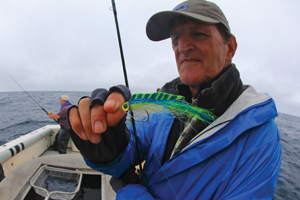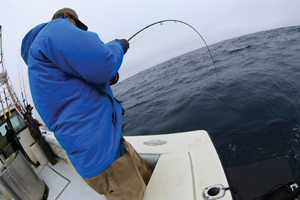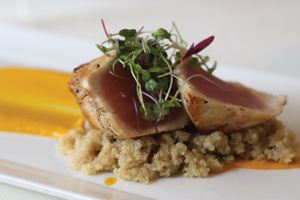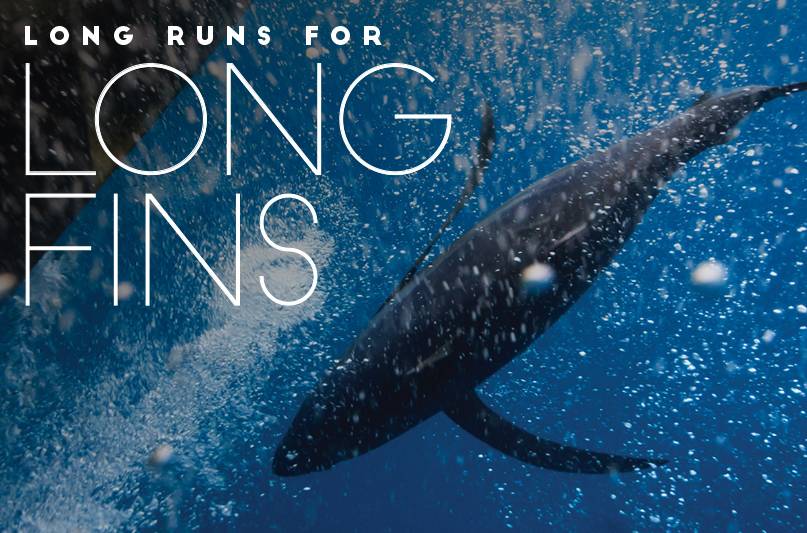
 More than 100 miles west of the Grays Harbor Bar of Washington, I was in a battle of life and death, flaked silver with fish scales and splattered with matador-red blood. To clarify, it was not my life on the line, but rather the dozens and eventually hundreds of albacore tuna I would haul in that day as a deckhand aboard the all-wood commercial tuna troller Anchor. We followed the telltale sign of diving birds to get here and now bobbed in the soup. Shark fins and leaping fish confused the water around us as hordes of seabird missiles dove through whale breath and ocean spray.
More than 100 miles west of the Grays Harbor Bar of Washington, I was in a battle of life and death, flaked silver with fish scales and splattered with matador-red blood. To clarify, it was not my life on the line, but rather the dozens and eventually hundreds of albacore tuna I would haul in that day as a deckhand aboard the all-wood commercial tuna troller Anchor. We followed the telltale sign of diving birds to get here and now bobbed in the soup. Shark fins and leaping fish confused the water around us as hordes of seabird missiles dove through whale breath and ocean spray.
The seas built, and large swells rose to starboard like fantastical, dimensionless aquariums with dolphins zipping through at eye level. The heaving primordial forces felt less like the ocean and more like a fevered dream.
“Get on those lines! They’re going to be on the bite!” My captain, Kurt, yelled from the helm on the open bridge. Between the lines on the outriggers that led to handy hydraulic gurneys to the shorter lines attached to the canoe transom via simple metal rings, I had over a dozen lines to keep an eye on. To make matters more complex, Kurt had a new jack pole [more on these later] he wanted to try out, and I was whipping that thing in all kinds of directions. I hooked a tuna on the pole, lifted the sucker out, and threw him clear over my shoulder and across the deck. One of the outrigger lines grew taut, and I flipped on the hydraulic winch to slowly bring it in.
Another of the short lines grew taut and I leapt to pull it by hand. Two more lines grew taut on the other outrigger. I flipped the switch to stop the first outrigger line just in time to deal with the newly hot lines while I continued to get mangled by the fighter on the short line in my hand. Another short line grew taut and the now abandoned jack pole at my side almost went overboard as I flailed about. The game of whack-a-tuna was in full swing.
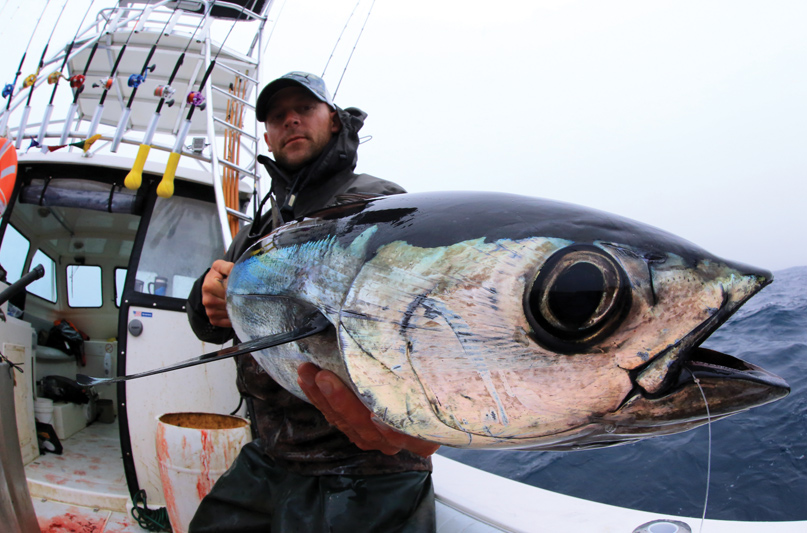
“Fish on!” I yelled, my code word for, “For ****sake, help!!!” Kurt appeared at my side and began to level the odds. Minutes then hours passed as the insatiable albacore swarm took the hooks as fast as we could put them back in the drink. Nature roiled around us, a God-sized gumbo of whale flukes and flashing
fish armies.
As suddenly as they were on, they were gone, and with them the entourage of the rest of the food chain. I, arms rubber and hands raw, stumbled over the carnage on deck. Bright red blood gathered in gory pools where dozens of tunas still fought. I gathered them up for the frozen hold below, each one renewed to battle in my grip to a bruising last stand. Shaped like a torpedo with a pair of pectoral fins that could’ve been designed by Boeing, albacore pack as much power as one could cram into an animal’s design. The sharp little finlet spines that line the tail nailed my hand more than once.
My work finally done for the day, I picked a good tuna for that night’s dinner; lightly seared albacore on a bed of jasmine rice with a hint of soy sauce and squeeze of lemon. Welcome to Albacore Alley.
For anglers ranging from the complete novice to the lifelong junkie, albacore tuna fishing in the Pacific Northwest stands as a common bucket list item. Tuna as recreational quarry are the quintessential open water fishing experience around these parts, associated with the wildest, deepest and bluest waters of the North Pacific. Once found, schools of feeding albacore get “on the bite” and eagerly chomp and run with almost anything that they come across, making for a thrilling experience.
Throw on the fact that freshly-caught albacore is flat-out delicious and that line trolling/rod caught U.S. North Pacific albacore tuna is one of the few fisheries rated as “Best Choice” on Monterey Bay Aquarium’s Seafood Watch List, and you’re checking off all the boxes. While most of us experience albacore from the can, the difference in delectability is as stark as a $2 can of salmon and a $50 fresh-off-the-fish salmon sashimi platter.
Albacore tuna are generally caught off the Washington and Oregon coasts throughout the summer and into the fall. However, August and September are widely considered the best months because generally there are the most fish and the weather on the North Pacific tends to be the most agreeable. Recreational anglers typically operate 50 to 100 nautical miles off the coast, so it is a proper open water experience. What’s more, multi-day trips (two or three days) are commonplace to make the most out of the extensive run to the tuna grounds.
Surprisingly, regulation is relatively new to the local recreational albacore tuna fishery. A recreational license wasn’t even mandated in Washington until 2006 and there still is no bag limit. Oregon currently has an albacore bag limit of 25 with few anglers reportedly making their limit with an average of 2.8 fish per day per angler in 2017.
One can catch albacore in Washington, Oregon, and California, (and even off British Columbia), but a glance at the numbers published by the 2017 HMS SAFE
(Highly Migratory Species Stock Assessment and Fishery Evaluation) report from the Pacific Fishery Management Council on fishery performance shows Washington as the most productive recreational (private boat and charter) fishery with Oregon generally in the same ballpark.
The success of the Washington fishery does not necessarily mean that the waters are the most productive. The greater number of chartering companies in Washington, specifically out of the albacore meccas of Westport and Ilwaco, could be a reason for the disparity of numbers.
Why do albacore tuna visit our waters in the summer? Why do they attack hooks in a ravenous swarm when on the bite? To answer these questions, we need to open up the albacore with our handy dissection scalpels and dust off our biology textbooks.
You don’t have to be a marine biologist to appreciate the incredible adaptations of the albacore tuna. The shape of the fish is that of a torpedo, perfectly hydrodynamic, and makes for one fast fish. Unfortunately, the exact maximum speed of albacore is still something mostly estimated by sea salts and not something that has been pinned down by biologists. According to a study published in 1992, a close cousin–yellowfin tuna–has been clocked out at 75 kilometers per hour (47 miles per hour). Think of it this way; albacore regularly outrun Mako sharks, one of their regular threats, and would probably get a speeding ticket on most residential roads in the U.S.!
The albacore doesn’t just owe its extreme performance to its bullet shape. Their long pectoral fins–the origin of their other name, longfin tuna–are similar to a design seen on the U.S. Navy’s Grumman F-14 Tomcat. The pectoral fins can be tucked close to the body for fast lineal sprints or instantly deployed outward for turn-on-a-dime maneuverability. Their tail, or caudal, fin is also sharply forked, another hallmark design of a fast fish.

Their ultimate weapon is within their very bright red blood, the entire circulatory system in fact. Unlike most fish, albacore tuna are warm-blooded, meaning they regulate their body temperatures like us mammals. Using a method of blood circulation known as counter-current blood exchange, albacore can maintain a high-performance metabolic furnace that keeps them fast moving and hungry. Essentially, cold-blood veins from the extremities pump blood back into the more central parts of the body where the veins run right next to outbound warm-blood arteries. The interaction transfers heat energy effectively between the two and keeps the fish’s body temperature constant.
This warm-bloodedness is also a key reason why albacore like our waters in the summer and fall. Albacore distribution is closely related to the temperature of the ocean because the fish want the best of both worlds: warm and cold waters. In warm water, albacore need to spend less energy (and therefore consume less food) to maintain their metabolism. However, cold water is more productive in terms of food supply, meaning that most of the goodies they want to eat (anchovies, sardines, herring, small squid, etc.) are found in colder waters. The albacore therefore “ride the edge” as they say in the biz, meaning that the tuna patrol the border between warm water where they prefer to play and the cold water where they prefer to work.
Where is this wonderous edge? Hopefully, right here off our coast! The usual seasonal setup involves warm water intruding from the south to the north in our summer and fall and the tuna come up with it. However, the typical sea temperature set-up is not something to take for granted, and the location of the edge (or lack of it) is one of the main factors that determine whether the season is going to be gangbuster or lackluster. If you recall all the news coverage of the warm water “blob” that plagued our coast from around 2013 to 2015, you’ll remember how irate coastal fishermen were. The edge, so vital to an albacore tuna fisherman’s livelihood, was pushed far away and remained elusive.
Now that you speak basic longfin, you’re more than ready to chase them down yourself. By far the best way to start reeling them in is to go with a local chartering guide. The tuna hubs of Washington, Westport and Ilwaco, are good places to start. Tuna fishing, due to its offshore and specialized nature, demands a dialed-in fishing machine to be safe and someone experienced aboard to be successful. While one can slap a used outboard motor on a dinghy, work the near-shore waters off San Juan Island with grandpa’s old rod, and maybe catch a silver salmon, the same kind of laid back approach will probably not work when in the North Pacific pursuing these fast-moving carnivores.
You’ll notice that your guide’s go-to strategy will probably be the classic jig and live bait combo. Jigs are generally trolled behind a vessel until the boat is on the tuna and they start biting. While fishermen work their lines, live bait like anchovy will be put on hooks as well to really get the fish biting. Operations
will even throw over live bait by the bucketload in conjunction with the trolling, anything to get that feeding frenzy mojo going.
I mentioned the jack pole in my introduction. If you’ve ever been in a kitschy chowder house on the West Coast and looked at a vintage photo of a commercial boat with a line of smiling guys chucking tuna over their shoulders with fishing poles like nothing, you’ve probably seen a jack pole.
These 10′ plus fishing poles are as simple as they come without a reel. Picture a big stick with a short line rigged with a jig and/or live bait on the hook, and you’re up to speed. In my opinion, these simple devices are the real tuna experience, and a lot of chartering companies have a few aboard as novelties. If you get the chance, give them a shot and burn some calories. If you really get on the tuna and master the technique, you’ll be throwing them on deck like it’s 1947.
As far as the nitty gritty of how to rig your line, I refer to your local professional guide and take notes. Everyone uses something different and what they use will change regularly. An old trick I’ve seen experienced tuna fishermen use is to examine what the fish they’ve caught have eaten. As gruesome as it sounds, landed tuna will often regurgitate the contents of their stomachs. Your guide may pick over these remains, see that the tuna has been eating a lot of squid, and change out jigs for squid-like designs.
Like always when you’re going into open water for extended periods of time, prepare. Bring those waterproof layers for both fair and foul weather. Start taking your favorite seasickness medications (if that’s a problem) the day before launch. If you don’t have a favorite that works for you, trial run medications on land and use the one that agrees with you best. Bring your favorite snacks, drink lots of water, and be ready for the chance of intense sun (sunglasses, hat, sunscreen, etc.). Invite your fun low-maintenance friends, ideally ones that have been on boats with you. A little preparation on land goes a long way towards a blast on the hunt.
Above all, have fun! Albacore fishing is an incredible Cascadian way to be a part of some of the ocean’s rawest and most exciting natural phenomena. If you’ve ever seen a shimmering bait ball under siege on a nature show, you’ll begin to get an idea of what you’re going to be a part of when chasing albacore. Find a recommended local guide, prepare a bit, and go on an epic adventure, the memories of which may last a lifetime. The sustainably caught seafood you’ll enjoy will be the cherry on top.
Read the full story on Issuu
